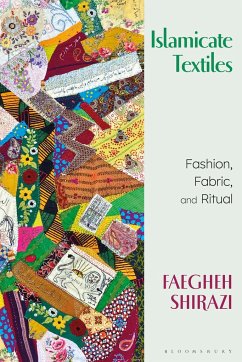29,99 €
inkl. MwSt.
Versandfertig in über 4 Wochen

15 °P sammeln
- Broschiertes Buch
- Merkliste
- Auf die Merkliste
- Bewerten Bewerten
- Teilen
- Produkt teilen
- Produkterinnerung
- Produkterinnerung
An insider's perspective on the diversity of textile traditions, culture and religious practices across Muslim cultures.
Andere Kunden interessierten sich auch für
![Crafting Textiles in the Digital Age Crafting Textiles in the Digital Age]() Crafting Textiles in the Digital Age36,99 €
Crafting Textiles in the Digital Age36,99 €![The Story of Colour in Textiles The Story of Colour in Textiles]() Susan Kay-WilliamsThe Story of Colour in Textiles39,99 €
Susan Kay-WilliamsThe Story of Colour in Textiles39,99 €![Sewing Techniques Sewing Techniques]() Jennifer PrendergastSewing Techniques28,99 €
Jennifer PrendergastSewing Techniques28,99 €![Cultural Threads Cultural Threads]() Jessica HemmingsCultural Threads53,99 €
Jessica HemmingsCultural Threads53,99 €![Catalogue of Textiles From Burying-grounds in Egypt; 1 Catalogue of Textiles From Burying-grounds in Egypt; 1]() Catalogue of Textiles From Burying-grounds in Egypt; 119,99 €
Catalogue of Textiles From Burying-grounds in Egypt; 119,99 €![English, French & American Furniture, Porcelains, Bronzes, Silver, Textiles and Tapestries, Eastern Rugs and Carpets English, French & American Furniture, Porcelains, Bronzes, Silver, Textiles and Tapestries, Eastern Rugs and Carpets]() English, French & American Furniture, Porcelains, Bronzes, Silver, Textiles and Tapestries, Eastern Rugs and Carpets22,99 €
English, French & American Furniture, Porcelains, Bronzes, Silver, Textiles and Tapestries, Eastern Rugs and Carpets22,99 €![Block Printing on Textiles Block Printing on Textiles]() Janet Doub EricksonBlock Printing on Textiles19,99 €
Janet Doub EricksonBlock Printing on Textiles19,99 €-
-
-
An insider's perspective on the diversity of textile traditions, culture and religious practices across Muslim cultures.
Hinweis: Dieser Artikel kann nur an eine deutsche Lieferadresse ausgeliefert werden.
Hinweis: Dieser Artikel kann nur an eine deutsche Lieferadresse ausgeliefert werden.
Produktdetails
- Produktdetails
- Verlag: Bloomsbury Academic
- Seitenzahl: 208
- Erscheinungstermin: 3. April 2025
- Englisch
- Abmessung: 234mm x 156mm x 25mm
- Gewicht: 454g
- ISBN-13: 9781350291263
- ISBN-10: 1350291269
- Artikelnr.: 70011749
- Herstellerkennzeichnung
- Libri GmbH
- Europaallee 1
- 36244 Bad Hersfeld
- gpsr@libri.de
- Verlag: Bloomsbury Academic
- Seitenzahl: 208
- Erscheinungstermin: 3. April 2025
- Englisch
- Abmessung: 234mm x 156mm x 25mm
- Gewicht: 454g
- ISBN-13: 9781350291263
- ISBN-10: 1350291269
- Artikelnr.: 70011749
- Herstellerkennzeichnung
- Libri GmbH
- Europaallee 1
- 36244 Bad Hersfeld
- gpsr@libri.de
Faegheh Shirazi is a Professor in the Department of Middle Eastern Studies at The University of Texas at Austin, USA. She is the author of Brand Islam: The Marketing and Commodification of Piety (2016), Velvet Jihad: Muslim Women's Quiet Resistance to Islamic Fundamentalism (2009), The Veil Unveiled: Hijab in Modern Culture (2001) and the Editor of Muslim Women in War and Crisis: From Reality to Representation(2010). Her research interests include textiles, dress, gender identity discourse, and material culture in the Middle East; the meanings of veiling; rituals and rites of passage as they relate to material culture.
Introduction
1. Textiles and Symbols: A Mélange of Cultural Signifiers
Kanga: Cloth with a message
Lion of Persia: From pre-Islamic to contemporary Iran
Felt and fabrics under domination: Central Asia
Ram's horn: Central Asia and Iran
2. Talismanic Textiles: Gender, Status, and the Supernatural
Protecting fiber and livelihood: The Ladakh
Blessed looms, blessed fibers
Sacred colors: Red, white, and light blue
Beyond the loom
Amulets: Protection against the unseen
Inscribed talismanic shirts
Gendered looms
3. The Politicization of Textiles: Colonialism to the Present
India and cotton: rejecting colonial rule
United we stand: India's Muslim weavers
West African wax cloth
Calico: The forbidden African cotton
Indian cloth in Southeast Asia
Keffiyeh: From functional to symbolic
The effect of Russian colonization on Central Asian politics
Tajikistan: Textiles and national branding
Soviet symbols on woven carpets
4. Refugees and Displaced Persons: Textile Signatures
The Siddis of India
Afghan refugee women: Embroidered lives
Weaving and war: Carpets depicting a nation under siege
Iraqi refugees: Textile arts of the past
Syrian and Iraqi refugees: Embroidered quilts and the charuga
Syrian refugees: The Ana collection
Weaving timeless symbols: War's impact on non-Muslim communities
5. Textiles and Death Rituals in Islamicate Societies
The burial garment for Muslims: The kafan
Piecing together the past
Tomb covers for the Prophet Muhammed: Kiswah
Tomb covers: Signifiers or status
Indian and South Asian tomb covers
Egyptian funeral tents: The art of Khayamiya
Conclusion
Glossary
Bibliography
Index
1. Textiles and Symbols: A Mélange of Cultural Signifiers
Kanga: Cloth with a message
Lion of Persia: From pre-Islamic to contemporary Iran
Felt and fabrics under domination: Central Asia
Ram's horn: Central Asia and Iran
2. Talismanic Textiles: Gender, Status, and the Supernatural
Protecting fiber and livelihood: The Ladakh
Blessed looms, blessed fibers
Sacred colors: Red, white, and light blue
Beyond the loom
Amulets: Protection against the unseen
Inscribed talismanic shirts
Gendered looms
3. The Politicization of Textiles: Colonialism to the Present
India and cotton: rejecting colonial rule
United we stand: India's Muslim weavers
West African wax cloth
Calico: The forbidden African cotton
Indian cloth in Southeast Asia
Keffiyeh: From functional to symbolic
The effect of Russian colonization on Central Asian politics
Tajikistan: Textiles and national branding
Soviet symbols on woven carpets
4. Refugees and Displaced Persons: Textile Signatures
The Siddis of India
Afghan refugee women: Embroidered lives
Weaving and war: Carpets depicting a nation under siege
Iraqi refugees: Textile arts of the past
Syrian and Iraqi refugees: Embroidered quilts and the charuga
Syrian refugees: The Ana collection
Weaving timeless symbols: War's impact on non-Muslim communities
5. Textiles and Death Rituals in Islamicate Societies
The burial garment for Muslims: The kafan
Piecing together the past
Tomb covers for the Prophet Muhammed: Kiswah
Tomb covers: Signifiers or status
Indian and South Asian tomb covers
Egyptian funeral tents: The art of Khayamiya
Conclusion
Glossary
Bibliography
Index
Introduction
1. Textiles and Symbols: A Mélange of Cultural Signifiers
Kanga: Cloth with a message
Lion of Persia: From pre-Islamic to contemporary Iran
Felt and fabrics under domination: Central Asia
Ram's horn: Central Asia and Iran
2. Talismanic Textiles: Gender, Status, and the Supernatural
Protecting fiber and livelihood: The Ladakh
Blessed looms, blessed fibers
Sacred colors: Red, white, and light blue
Beyond the loom
Amulets: Protection against the unseen
Inscribed talismanic shirts
Gendered looms
3. The Politicization of Textiles: Colonialism to the Present
India and cotton: rejecting colonial rule
United we stand: India's Muslim weavers
West African wax cloth
Calico: The forbidden African cotton
Indian cloth in Southeast Asia
Keffiyeh: From functional to symbolic
The effect of Russian colonization on Central Asian politics
Tajikistan: Textiles and national branding
Soviet symbols on woven carpets
4. Refugees and Displaced Persons: Textile Signatures
The Siddis of India
Afghan refugee women: Embroidered lives
Weaving and war: Carpets depicting a nation under siege
Iraqi refugees: Textile arts of the past
Syrian and Iraqi refugees: Embroidered quilts and the charuga
Syrian refugees: The Ana collection
Weaving timeless symbols: War's impact on non-Muslim communities
5. Textiles and Death Rituals in Islamicate Societies
The burial garment for Muslims: The kafan
Piecing together the past
Tomb covers for the Prophet Muhammed: Kiswah
Tomb covers: Signifiers or status
Indian and South Asian tomb covers
Egyptian funeral tents: The art of Khayamiya
Conclusion
Glossary
Bibliography
Index
1. Textiles and Symbols: A Mélange of Cultural Signifiers
Kanga: Cloth with a message
Lion of Persia: From pre-Islamic to contemporary Iran
Felt and fabrics under domination: Central Asia
Ram's horn: Central Asia and Iran
2. Talismanic Textiles: Gender, Status, and the Supernatural
Protecting fiber and livelihood: The Ladakh
Blessed looms, blessed fibers
Sacred colors: Red, white, and light blue
Beyond the loom
Amulets: Protection against the unseen
Inscribed talismanic shirts
Gendered looms
3. The Politicization of Textiles: Colonialism to the Present
India and cotton: rejecting colonial rule
United we stand: India's Muslim weavers
West African wax cloth
Calico: The forbidden African cotton
Indian cloth in Southeast Asia
Keffiyeh: From functional to symbolic
The effect of Russian colonization on Central Asian politics
Tajikistan: Textiles and national branding
Soviet symbols on woven carpets
4. Refugees and Displaced Persons: Textile Signatures
The Siddis of India
Afghan refugee women: Embroidered lives
Weaving and war: Carpets depicting a nation under siege
Iraqi refugees: Textile arts of the past
Syrian and Iraqi refugees: Embroidered quilts and the charuga
Syrian refugees: The Ana collection
Weaving timeless symbols: War's impact on non-Muslim communities
5. Textiles and Death Rituals in Islamicate Societies
The burial garment for Muslims: The kafan
Piecing together the past
Tomb covers for the Prophet Muhammed: Kiswah
Tomb covers: Signifiers or status
Indian and South Asian tomb covers
Egyptian funeral tents: The art of Khayamiya
Conclusion
Glossary
Bibliography
Index







